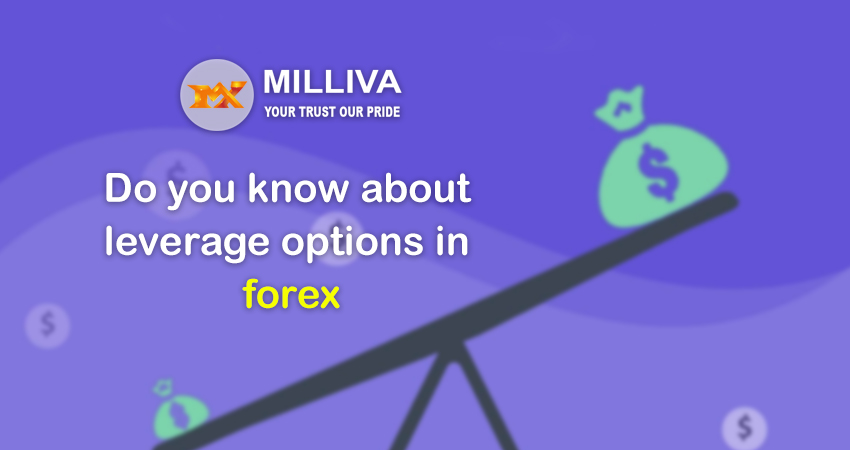How Leverage Works in the Forex Market

![]()
In the forex market, leverage is a method for traders to borrow money. In order to obtain a bigger exposure to the forex market. They can handle a greater trading size with a little quantity of cash.
Because gains and losses calculated based on the whole value of the position. This might result in larger earnings and losses.
How Does Leverage Work?
Leverage allows you to raise your access to an underlying asset by putting down a deposit, known as margin. You’re essentially putting down a little portion of the total value of the deal. And your supplier is lending you the rest. The leverage ratio is the amount of total exposure compared to your margin.
Leverage Amounts (Leverage Options )
Leverage is normally provided in a predetermined amount that varies depending on the broker. Each broker distributes leverage according to its own set of rules and regulations. Typical ratios include 1:50, 1:100, 1:200, 1:400, and 1:500.
1:50 – leverage implies you may conduct a transaction for up to $50 for every $1 you have in your account.
1:100 – leverage implies you may conduct a transaction for up to $100 for every dollar you have in your account.
1:200 – leverage implies you may conduct a transaction for up to $200 for every $1 you have in your account.
1:400 – leverage implies you may conduct a transaction for up to $400 for every $1 you have in your account.
1:500 – leverage implies you may conduct a transaction for up to $500 for every $1 you have in your account.
How to Calculate Leverage?
A forex leverage calculator can assist traders figure out. How much money they’ll need to create a new position and manage their existing ones. By establishing the ideal position size, it also assists them in avoiding margin calls.
The formula for calculating forex leverage is as follows:
L = A / E
(Where L – leverageE – Margin (equity),A – Asset value.)
Milliva – The Best Trading Platform with High Leverage
Milliva offers 2 different leverage options according to the account types,
Types of account in Milliva:
Micro,Standard,Elite,ECN,Premium

Milliva offers up to 1:500 leverage for certain account types like Micro, Standard, Elite, ECN, and 1:200 leverage to premium account holders.
How to use Leverage in Your Trading?
When Leverage is 1:500
The ratio of a trader’s money to the borrow capital borrow from the broker known as leverage in currency. For example, 1:500 leverage indicates that a trader has borrowed $5000 from their currency broker for every dollar in their currency account.
As a result, if a trader has $100 in their currency trading account, they will have borrowed using 1:500 leverage, resulting in $100*1:500 leverage, or $50000 in currency trading capital.
When Leverage is 1:200
The ratio of a forex trader’s money to the borrow capital borrow from the forex broker known as leverage in forex. For example, a trader with leverage of 1:200 has borrowed $200 from their forex broker for every $1 in their account.
If a trader has $100 in their forex trading account, they will have borrowed using 1:200 leverage, resulting in $100*1:200 leverage, or $20,000 in forex trading capital.
How to Acquire Leverage in Milliva?
To acquire leverage your 1st step is to create a live account in Milliva, Then make your deposit which is your margin. The amount of money required by your forex broker in order for you to continue trading with the leveraged amount is known as forex margin.
The amount you deposit to start a Forex account is known as the margin. Your forex margin is $100 if you deposit $100.
Your leverage will be based on which account you are choosing if you choose a premium account then your leverage will be 1:200. If you choose Micro, Standard, Elite, ECN then your leverage will be 1:500.
How to Start a Live Forex Trading Account in Milliva?
Sign up for a Free account at Milliva
Complete the KYC process with the appropriate documents.
Make a deposit.
Start trading.
Advantage and Disadvantages of Leverage in Forex
Advantage
Increases Capital
Leverage increases the amount of money accessible to invest in different markets. With a 100:1 leverage, for example, you may effectively manage $100,000 in trading capital with only $1,000. As a result, you’ll be able to dedicate significant funds to various trade positions in your portfolio.
Interest
There is no charge for this loan. Leverage is a borrowed funds to increase one’s trading position from your broker
There are no responsibilities in the form of interest or commission with this ‘loan,’ and you can use it you like while trading.
Profits Increased
Leveraged trading allows traders to profit from transactions that go in their favour by multiplying their winnings. Profits are made on the trading position that is controlled, not on the margin that is put down. This also means that traders may make a lot of money even if the underlying assets only fluctuate a little bit in price.
Low Volatility Risk Mitigation
Market price movements are frequently accompanied by periods of high and low volatility. The majority of traders enjoy trading since it allows them to profit from market swings. As a result, low volatility periods may be extremely irritating for traders due to the lack of market movement.
Thankfully, leveraged trading allows traders to possibly make more money even during these seemingly “boring” periods of low volatility.
Premium Markets Trading
Traders might use leverage to trade items that are seen to be more expensive or prestigious. Some products have a premium pricing, which can keep many retail investors out.
However, such markets or assets may be traded using leverage, exposing the typical retail investor to the numerous trading possibilities they provide.
Disadvantages
Losses that have been Amplified
When trading with leverage, the main danger is that, like profits, losses are increased when the market goes against you. Although leverage requires a little initial investment, losses can be enormous because trading results are reliant on the overall position size you control.
Risk of a Margin Call
When floating losses exceed your utilized margin, your broker will issue a dreaded ‘Margin Call.’ When you have open trading positions in the rapid and dynamic financial markets, there is always the potential of a ‘margin call’ since leverage magnifies losses.
While the margin is the amount of money necessary to open a transaction, leverage is money borrowed from the broker to get access to greater trading positions. As a result, margin forex trading allows traders to create bigger positions with relatively little deposits.
It’s crucial to remember that trading on leverage is dangerous because both losses and profits are magnified.

Visit us : www.milliva.com





